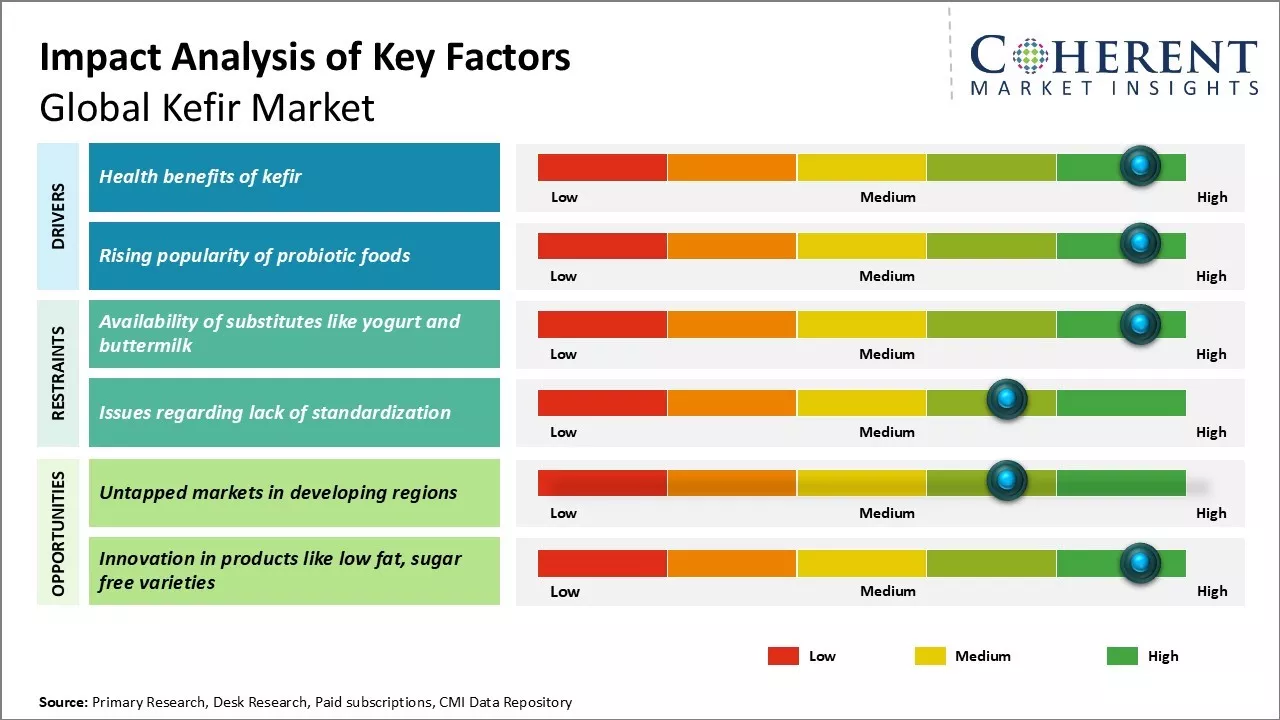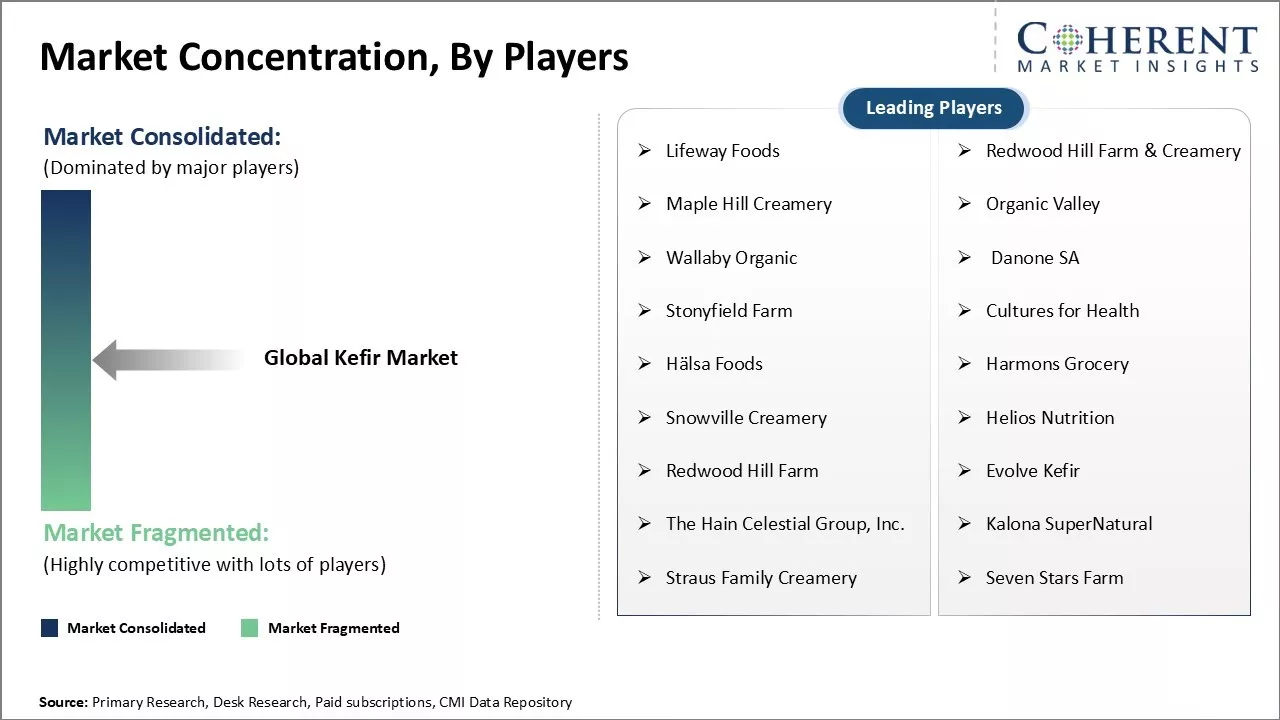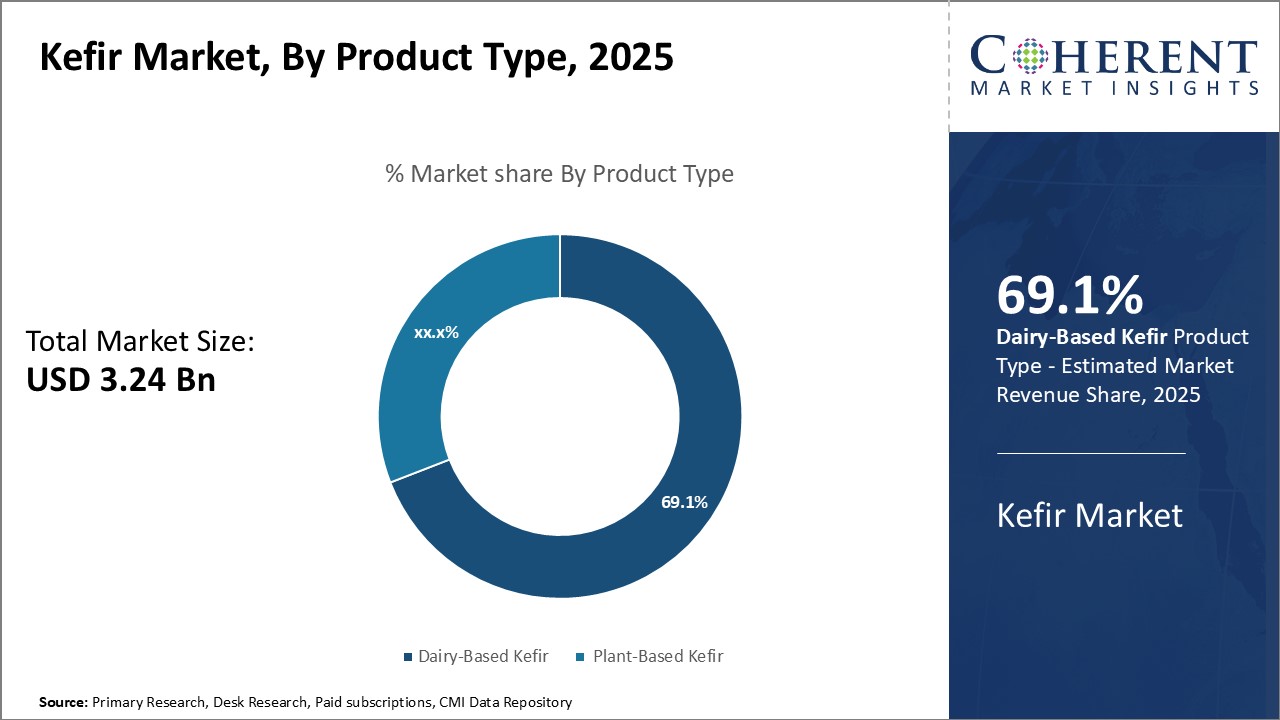The global kefir market is estimated to be valued at USD 3.24 Bn in 2025 and is expected to reach USD 5.11 Bn by 2032, exhibiting a compound annual growth rate (CAGR) of 6.7% from 2025 to 2032.

Discover market dynamics shaping the industry: Request sample copy
Kefir has gathered widespread popularity as a probiotic dairy beverage with various health benefits. Rising health consciousness among consumers and shift toward plant-based and probiotic products have been driving the demand for kefir globally. Additionally, increasing spending on functional beverages and innovations with new flavors and formats by manufacturers are augmenting the market expansion.
Market Driver - Health benefits of kefir
Kefir is gaining widespread popularity due to the various health benefits it provides. Made from fermented milk, kefir contains a variety of probiotic cultures that can boost digestive health and immunity. The probiotic cultures in kefir help promote a balanced gut environment and facilitate nutrient absorption. A balanced gut microbiome plays a vital role in maintaining overall wellness. Research shows that kefir probiotics may help reduce the symptoms of digestive issues like constipation, indigestion, and lactose intolerance. Its probiotic makeup has anti-inflammatory properties as well that can soothe gut discomfort.
The probiotic cultures in kefir also bind to and consume harmful pathogens in the gut, reducing their numbers and impact. This may aid in preventing gut infections and diarrhea. Regular consumption of kefir probiotics helps crowd out undesirable microorganisms in the digestive tract. Some studies indicate kefir's probiotic content may even reduce risk of intestinal disorders like ulcerative colitis and irritable bowel syndrome over time. Its gut health benefits allow more efficient assimilation of nutrients from food as well.
Beyond digestive advantages, kefir is rich in immune boosting proteins and anti-oxidants. Its probiotic makeup strengthens the gut barrier and supports immune function. This could lower the risk of common illnesses. Reports show kefir consumption may alleviate allergies and asthma symptoms in susceptible individuals due to its anti-inflammatory properties. Some preliminary data also links kefir probiotics to reduced severity of conditions like rheumatoid arthritis. More research is still required but its immune modulating potential is promising.
The calcium, vitamin B, and vitamin K content of kefir additionally supports bone health. Studies suggest probiotic therapy may help optimize bone mineral density. Regular consumption of kefir may therefore lower the risk of osteoporosis and joint disorders in older people. Its rich nutrient profile along with gut health advantages make kefir a nourishing addition to daily diets. The numerous potential wellness benefits are driving more people to incorporate this fermented milk drink as part of a healthy lifestyle.

Get actionable strategies to beat competition: Request sample copy
Rising popularity of probiotic foods
Consumer awareness around gut and total wellness is spurring increased interest in probiotic foods globally. People are seeking convenient ways to boost their digestive and immune function through diet. Probiotic microorganisms are live microorganisms that supposedly provide health benefits when consumed. Research has illuminated the role gut microbiota play in overall health from mental wellbeing to metabolism. This is driving demand for probiotic ingredients across various food and beverage categories.
As a fermented dairy product, kefir perfectly complements the rising preference for probiotic nutrition sources. Unlike capsule supplements, kefir offers a delicious and enjoyable way to consume beneficial live cultures. The prospect of naturally fortifying one's microbiome appeals to many. Probiotic beverages especially match busier modern lifestyles as effortless wellness boosters’ people can easily incorporate anywhere. Their appetite appeal also makes them top choices for families with children.
Consumers seeking to manage digestive issues or boost immunity have gravitated toward probiotic ingredients. Media attention on gut-brain connections and microbiome impacts is raising recognition of their significance. Millions suffer from stomachache, diarrhea, constipation, and food intolerances motivating them to explore probiotic solutions. Their availability in refreshing, everyday beverages address such health priorities with low effort. Even the asymptomatic population sees value in bolstering gut ecological balance for long-term protection against disease risks.
Sustainable sourcing and minimal processing requirements of fermented items additionally resonate with evolving buyer values. Probiotic products address priority around food transparency with their simple, natural formulations satisfying health-conscious and eco-minded demographics. Marketing highlighting gut microbiome optimization and immunity boosting separates them from common beverages.
Key Takeaways from Analyst:
The global kefir market is poised to grow at a significant rate over the coming years. The market is driven by increasing health consciousness among consumers and a rising preference for probiotic foods. Kefir offers several gut and digestive health benefits due to the presence of probiotics which aids in digestion. This factor is expected to remain a key growth driver. Meanwhile, product innovation with various flavors and ingredients is also fueling the industry. More companies are developing kefir-based drinks, shakes, and desserts to cater to changing consumer tastes.
The market also faces challenges from some restraints. Availability of substitute probiotic products limits the growth potential of kefir. High preference for locally produced goods particularly in developing countries is also hindering the markets expansion.
From a geographical standpoint, North America currently dominates the global kefir market and is expected to continue its leadership. Widespread awareness about kefir's health advantages along with traditional usage makes Europe a lucrative region. Meanwhile, Asia Pacific is identified as the fastest growing regional market attributed to rising living standards, growing health consciousness, and expansion of retail chains in developing nations. Kefir companies should focus on capitalizing opportunities in Asia Pacific to cement their position in the global industry. Strong distribution networks especially in populous countries like India and China will be critical for success.
Market Challenge - Availability of substitutes like yogurt and buttermilk
The global kefir market is facing significant challenge due to the presence of close substitute dairy products like yogurt and buttermilk. Both yogurt and buttermilk are widely sold and marketed products across various regions of the world. Yogurt market is especially highly competitive due to strong marketing and distribution network of major yogurt manufacturers. Both yogurt and buttermilk provide similar functional benefits to gut health and probiotics as kefir. The taste profile of these substitutes is also relatively universal which makes them appealing to mass market. Many consumers are unable to distinguish the difference in product attributes and nutrition composition between kefir and other substitutes. This has restricted kefir to remain a niche product consumed by only health conscious population. The challenge for kefir producers is to position their brand differently and create broader awareness about unique features of kefir to outperform strong competition from substitute products.
Market Opportunity - Untapped markets in developing regions
The global kefir market has potential growth opportunity in numerous developing regions which are yet to witness the wider availability and consumption of kefir. While yogurt and buttermilk markets in these regions are getting saturated steadily, kefir remains largely unknown to mass population. Countries across the Middle East, Africa, Latin America, and parts of Asia Pacific represent very low penetration levels of kefir currently. These untapped emerging markets bear high prospects for kefir producers to focus their expansion strategies. With increasing health and wellness trends, improved cold chain logistics and rising disposable incomes, consumers in developing regions are likely to get exposed to kefir in the coming years. Early mover advantage through innovative market entry models and localized branding can help players gain substantial market shares in the long run. Partnerships with local distributors may also facilitate faster availability of kefir to tap into development targets.

Discover high revenue pocket segments and roadmap to it: Request sample copy
Insights by product type: Consumer preference for nutritional dairy products drives the growth of dairy-based kefir
In terms of product type, dairy-based kefir is expected to contribute 69.1% share of the market in 2025 owing to growing consumer preference for nutritional dairy products. Kefir made from dairy sources such as cow, goat, and sheep milk offer several health benefits due to the presence of probiotics. Consumption of probiotics through dairy kefir helps improve gut health, boost immunity, and reduce inflammation. The growing health consciousness among people has raised the demand for probiotic enriched dairy foods like kefir. Moreover, dairy kefir is richer in protein and other essential nutrients compared to plant-based varieties.
The availability of dairy kefir in different fat contents also appeals to a variety of consumers. Low-fat and fat-free dairy kefir are gaining popularity among health-conscious people watching their calorie and fat intake. On the other hand, whole fat dairy kefir remains popular for its rich taste and higher nutrition value. The versatility in terms of fat content has expanded the customer base of dairy kefir. The widespread distribution of dairy kefir in grocery stores, health food shops, and online channels further enhance its accessibility. Developed regional markets like North America and Europe contribute significantly to the growth of dairy-based kefir owing to evolution of on-the-go lifestyles and focus on gut health.
Insights by flavor: Rising health awareness fosters the growth of plain/natural flavored kefir
In terms of flavor, plain/natural is expected to contribute 49% share of the market in 2025. The growth of this segment is attributed to rising health consciousness among consumers and clean label trends. People are increasingly adopting simple and natural food options to meet their nutrient needs instead of heavily processed foods. Plain or natural flavored kefir satisfies this consumer preference since it contains simple ingredients like milk and kefir cultures without any flavorings or added sugars. Furthermore, preferences for minimal ingredients and labels resonate well with clean eating practices followed by many. Natural and plain kefir provides probiotic benefits in their purest form without unnecessary additions.
The clean taste profile of plain kefir also appeals to people who want the basic taste of the dairy product. It allows consumers to enjoy the subtle taste of milk and cultures without any flavor masking. This encourages regular consumption of kefir for its gut health effects. Plain kefir is also suitable for people who do not prefer strong flavors like fruit varieties. Its versatility in terms of simple flavor profile and clean label has boosted the growth of this segment. Rising availability of plain kefir options through major retail channels and brands further drives its growth.
Insights by distribution channel: Expanding retail landscape accelerates growth via supermarkets/grocery stores
In terms of distribution channel, supermarkets/grocery stores is expected to contribute 54.8% share to the global kefir market in 2025, owing to the expansion of modern retail in recent years. The growing network of supermarkets, hypermarkets, and grocery stores in key regions provides increased accessibility and visibility to kefir products. Customers can find a diverse range of local as well as international kefir brands under one roof along with other dairy items and foodstuffs. This offers added convenience when shopping for regular household items as well as specialty products like kefir.
Supermarkets stock a variety of kefir types according to local preferences including Greek style strained kefir, drinkable kefirs, and fruit-flavored varieties. Attractive multi-packs or family-size containers in their dairy sections boost trial and replenishment purchases. Shopping mall culture and rapid urbanization have also strengthened organized retailing channels in developing Asian and Latin American markets. Rising digital influenced consumers additionally rely on e-commerce grocers for doorstep delivery of kefir and other frozen/chilled products. These factors collectively contribute to supermarkets consolidating their status as a primary retail gateway for the global kefir market.

Need a Different Region or Segment? Customize now
North America has been dominating the global kefir market for several years owing to a well-established dairy industry and high health consciousness among consumers in the region with 40.2% share in 2025. Countries like the U.S. and Canada have a strong presence of local as well as international dairy brands that offer a wide range of kefir products. Moreover, the changing food habits and increasing preference for probiotic foods provide major growth opportunities for the kefir market in North America.
Another fast-growing regional market is Asia Pacific. The Asia Pacific kefir market is led by China due to growing awareness about gut health and nutritional benefits of fermented milk products. The Chinese market continues to attract foreign investments and joint ventures between local and international brands. There is a rise in the manufacturing of kefir and other probiotic yogurt especially in southern Chinese provinces due to the availability of raw materials and cheap labor. Countries like India and Japan are also emerging as high potential markets. With improving cold chain infrastructure, retail landscape and growing health consciousness, the demand for kefir and other probiotic products is surging rapidly across Southeast Asian countries. Further, several international brands see Asia Pacific as an important region and are focusing on partnerships with local distributors for expanding retail reach.
Kefir Market Report Coverage
| Report Coverage | Details | ||
|---|---|---|---|
| Base Year: | 2024 | Market Size in 2025: | USD 3.24 Bn |
| Historical Data for: | 2020 To 2024 | Forecast Period: | 2025 To 2032 |
| Forecast Period 2025 to 2032 CAGR: | 6.7% | 2032 Value Projection: | USD 5.11 Bn |
| Geographies covered: |
|
||
| Segments covered: |
|
||
| Companies covered: |
Lifeway Foods, Redwood Hill Farm & Creamery, Maple Hill Creamery, Organic Valley, Wallaby Organic, Danone SA, Stonyfield Farm, Cultures for Health, Hälsa Foods, Harmons Grocery, Snowville Creamery, Helios Nutrition, Redwood Hill Farm, Evolve Kefir, The Hain Celestial Group, Inc., Kalona SuperNatural, Straus Family Creamery, and Seven Stars Farm |
||
| Growth Drivers: |
|
||
| Restraints & Challenges: |
|
||
Uncover macros and micros vetted on 75+ parameters: Get instant access to report
*Definition: The global kefir market consists of sales of probiotic kefir products. Kefir is a fermented milk drink that originated from the Caucasus mountains. It is produced by inoculating cow, goat, or sheep milk with kefir grains containing various microorganisms like lactic acid bacteria and acetic acid bacteria. The kefir market includes unsweetened, sweetened, and flavored kefir products that are sold in supermarkets, health stores, specialty stores, and online. The global kefir market is growing steadily driven by rising awareness around digestive and gut health benefits of probiotic foods.
Share
Share
About Author
Yash Doshi is a Senior Management Consultant. He has 12+ years of experience in conducting research and handling consulting projects across verticals in APAC, EMEA, and the Americas.
He brings strong acumen in helping chemical companies navigate complex challenges and identify growth opportunities. He has deep expertise across the chemicals value chain, including commodity, specialty and fine chemicals, plastics and polymers, and petrochemicals. Yash is a sought-after speaker at industry conferences and contributes to various publications on topics related commodity, specialty and fine chemicals, plastics and polymers, and petrochemicals.
Missing comfort of reading report in your local language? Find your preferred language :
Transform your Strategy with Exclusive Trending Reports :
Frequently Asked Questions
Joining thousands of companies around the world committed to making the Excellent Business Solutions.
View All Our Clients
US Reciprocal Tax Impact Analysis On Kefir Market
Stay updated on tariff changes with expert insights and timely information